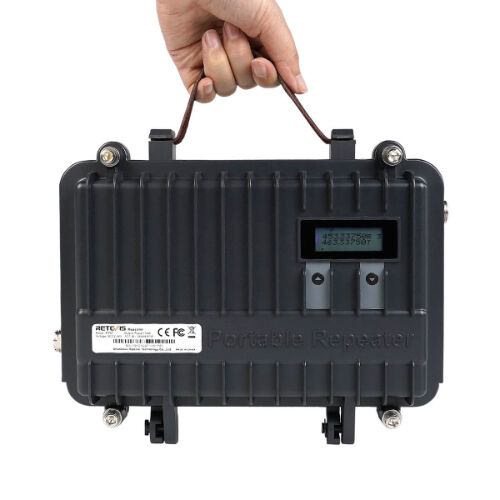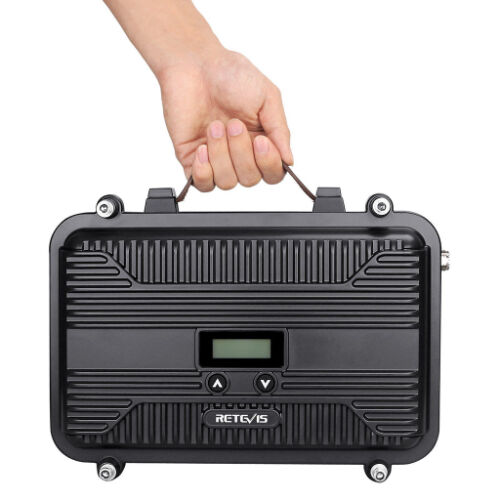How to Build a Radio Repeater?

How to Build a Radio Repeater?
Communication is crucial these days. If you’re interested in learning how to build a radio repeater, you’ve come to the right place.
We’ll look at what a radio repeater is, how it works, and how to make one DIY repeater in this post. Finally, using the proposed full-duplex communicator architecture in this article, you will be able to construct a mini repeater station.
What is a Radio Repeater?
Consider the following scenario: Person ‘A’ can communicate with person ‘B’ by walkie-talkie, but ‘B’ cannot respond simultaneously, and vice versa.
There may be barriers in the way of modulated signal propagation from walky-talky ‘A’ to walky-talky ‘B,’ such as mountains, buildings, trees, and so on. Because of these barriers, the range of the propagated signals may be reduced, and the person on the receiving end may receive heartbroken messages.
To avoid problems like this, we use a radio repeater. A radio repeater extends the range of the sent signal, sometimes up to 100 kilometers, ensuring that the receiving party receives a clear signal. When you build a repeater with two mobile radios, it’ll help to increase the range of the signal being delivered.
The repeater station is built on top of hills to receive the maximum signal from a node and re-transmit it with less distorted signal to single or multiple nodes. Only when the repeater is within range of the transmitting node will it rebroadcast the signal to numerous nodes.
How to Build a Radio Repeater?
1. Repeater Site Survey
First and foremost, this process can also refer to how you set up a ham radio repeater-or amateur radio repeater. Typically, a ham radio repeater is an electronic device that transmits a low-level signal to a higher level. Thus, the signal’s quality can be maintained even when traveling long distances. Depending on the configuration, two-way radio installation can be either moderately tricky or exceedingly simple.
Two antennas are generally required for high-power repeaters, each of which does the job of receiving or transmitting. Please note that you should seek help and advice from a professional since this method is not quite suitable for inexperienced users. Yet, for shorter distances, a conventional repeater just requires one repeater antenna, which is more straightforward for many to replicate. This type of repeater is often a hand-held device that sends and receives signals from two way radios.
The location of the antennas in a two-antenna system is crucial because it keeps the receiving antenna from absorbing energy from the broadcasting antenna. To reduce interference, you should consider different heights to set up your antennas.
Some repeaters contain a built-in or add-on duplexer to make installation easier. This component allows simultaneous signal processing on one antenna, consisting of circuits that separate the transmitter and receiver. In this method, the radio frequency of the transmitter does not harm the receiver. After that, the repeater is placed together with a high-performance antenna at the area’s tallest point. By doing this, the overall functioning and effectiveness of signals are substantially enhanced.
Before taking the radio coverage test (which we mention in the next part), remember that your site study always plays a crucial part to ensure the proper operation of your repeater.
2. Find the Right Position
When you’re done with site surveying, it’s time to find the correct installation location to finish setting up a radio repeater. Your antenna position must be taken care of properly; otherwise, your radio communication performance should never live up to your expectations. Despite all the pressure, as stated above, it’s not difficult to choose a suitable location for the repeater. In radio transmission, pay attention to the line of sight. Signal transmission can be hampered by trees, electricity towers, hillsides, or any other objects that have a dense structure.
Sometimes, your radio repeater can still work well without a clear line of sight. However, chances are you’re not gonna be lucky all the time. Don’t give up on finding a prime spot too soon, unless you don’t have any other options.
3. Install the Repeater and Test the Setup
If you don't need a lot of power and you want an easy setup, the Retevis RT97S series repeater is your device. Out of the box, this thing was ready to go. You are easily able to get my handhelds programmed and working with this repeater. The RT97 series repeater can extend the radio communication range, provide longer talking distance, and provide clearer voice quality. At present, the RT97 series repeater includes RT97, RT97S, and RT97P. Each one has several versions, such as UHF, VHF, and customizable versions. You can choose the right version according to the frequency you require and your usage environment. And some kits come with high-gain antennas and other accessories to achieve better communication.
Retevis RT97 Portable UHF Repeater
Retevis RT97S GMRS Mobile Repeater
Retevis RT97P UHF DMR Repeater
After the repeater is set up in the right position, the final step is to test your setup. Follow the manufacturer’s instructions to program your two way radio. This includes setting up channels, squelch settings, and other features. If you live in a quite populated area, setting up CTCSS/DCS privacy codes can keep your GMRS, FRS, or MURS radio quiet except for calls from your group. In a real emergency, you’ll want to turn these off so you can hear what’s going on around you.
Thank you for reading this blog! If you have any questions, please leave your comments below. We are looking forward to your comments!









